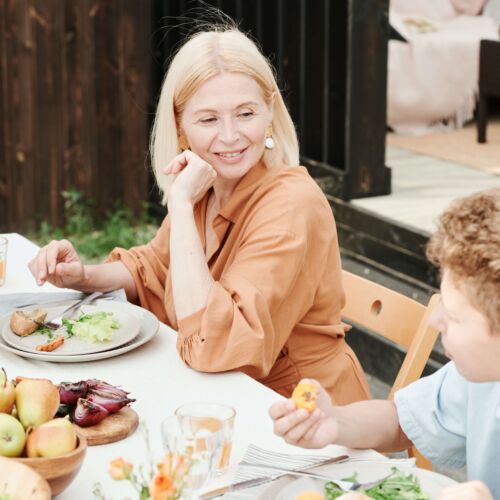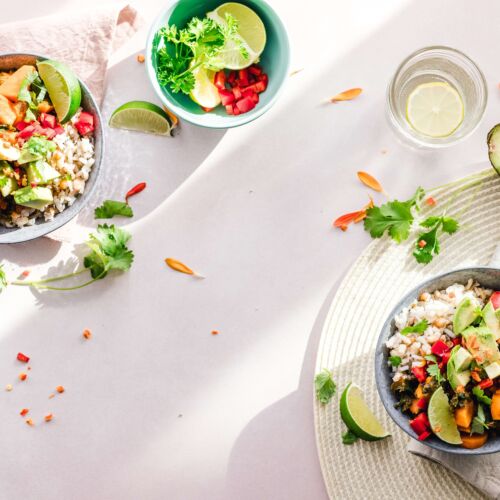Feel Your Fullness
by Dawid Furman

Feeling Your Fullness is the fifth principle of Intuitive Eating outlined by Tribole & Resch in the Intuitive Eating Workbook.
To truly know when you have had enough food, you should listen to signals sent by your body that tell you that you are not hungry anymore.
When eating you should observe for signals until you reach a level where you are comfortably full.
To know when you reach a level where you are comfortably full, you should pause in the middle of eating and assess the taste of food and your fullness level.
Follow on reading for 5 tips on how to Feel You Fullness:
1. Create the Optimal Eating Environment
In order to connect with your physical sensations of fullness it is important to get rid of many barriers that may disrupt your ability to feel fullness, such as using a phone when eating.
Despite your ability to multitask, your brain can only focus on one thing at a time, which means you may not feel the sensory aspects of food when eating distractedly.
If you are engaged in other things while eating, not only will your enjoyment of food go down but also so will your fullness cues, which may make you overeat.
For this reason, you should eat in an environment you feel comfortable in, that is free of distractions, which will make you be able to truly connect with your body and enjoy food.
This can be done by setting boundaries such as not eating with phones or not eating when standing and by creating a pleasant eating environment, such as eating in a regular place like the kitchen with a pleasant vibe with for example music playing.
2. Ditch the Clean Plate Mentality and Be Able to Say “No”
A large barrier to honouring your fullness is the belief that you should finish all the food on your plate, regardless of your hunger level.
This behaviour often results from parental rules from childhood as well as being too hungry or eating at a pace that is too fast.
If you are one of these people who does this, try leaving one or two bites of food uneaten with each meal, which will help you break the habit of eating without considering fullness.
Another behaviour that may stop you from honouring your fullness is being afraid to say no when being offered food in a social setting.
You should remember that there is nothing wrong with saying no to this when full, as it is not your responsibility to make someone happy by eating their food.
3. Be Able to Feel the Characteristics of Fullness
Fullness can make your body feel in different ways for example bloating in your stomach or a lower desire to eat.
It is easy to miss the characteristics of fullness, so for this reason it is important to eat slowly to be able to regularly check in with your body.
Tribole & Resch suggests that you can practice feeling sensations of fullness by slowly drinking carbonated water in a room without distractions over a five-minute period and after feeling sensations of fullness ask yourself how much water you drank, describe the sensation of swallowing the water and lastly compare the sensation to feeling fullness from food.
4. Be Aware of Factors That Influence Fullness
There are a number of factors that can have an impact on how much food you need to reach a level of comfortable fullness.
Factors such as initial level of hunger, giving yourself unconditional permission to eat, timing, amount of food, social influence as well as type of food are all factors that can influence fullness.
Foods which contain protein, fats, carbohydrates and fibre often increase levels of satiety due to numerous factors which can influence fullness.
If you consume low calorie foods with little staying power such as “air foods” like rice cakes, you may be initially full but hunger will return an hour or two later.
Try to experiment how different foods affect your fullness level yourself by reflecting and comparing on how long each snack kept you full as well as why you think this happened. Try to implement what you learn from this to snack choices.
5. Find Meals with Staying Power
You can apply the same as above paragraph, except this time with meals, select some of your most popular meals over the weeks and rate how long your fullness lasts after these meals, with check-ins every 30 minutes.
After noting how long it took to get hungry again after each meal reflect what meals helped sustain your hunger for the longest.
6. Find the Nuance of Fullness
You will need a lot of practice listening to your hunger before you’ll truly be able to tell you’re comfortably satisfied.
Start a journal with a rating of your hunger between 1-10 before a meal or snack and then during consumption pause and ask yourself information on taste and sensations of diminishing hunger and lastly finish off with a rating of hunger after having enough to eat as well as is the feeling pleasant or not?
Now reflect at what rating did you start feeling full and was this fullness pleasing or not. A true nuance of fullness often happens between 6 and 8.
The more experience you get with rating your fullness the closer you will become to being able to identify the last bite threshold which suggests you should stop eating at the present time.
Your body will be able to feel that this is the last bite before you will be comfortably satisfied.
If you found this blog post interesting, please continue reading our 10-principle series on Intuitive Eating. Intuitive Eating is challenging but with the help of a Registered Dietitian it is common that clients will break through and get off their diet rollercoaster for the long haul and open up space in their life to feel more freedom.
If you are interested to learn more about Intuitive Eating, continue on reading:
- Ditch The Diet Mentality
- Honor Your Hunger
- Make Peace With Food
- Challenge The Food Police
- Feel Your Fullness
- Discover The Satisfaction Factor
- Cope with Your Feelings Without Using Food
- Respect Your Body
- Exercise: Feel the Difference
- Honour Your Health: Feel the Difference
Find Your Registered Dietitian here:
On Dietitian Directory you can find all sorts of Dietitians including Intuitive Eating Dietitians, Weight Inclusive Dietitians, Mindful Eating Dietitians and Emotional Eating Dietitians
About the Author: Dawid Furman is a nutrition and exercise science student studying at the South East Technological University in Ireland and hopes to pursue a career as a dietitian in the future.
Reviewed by: Lindsey McGregor, RD,
Images from: Unsplash and Pexels
The Site is not intended to be a substitute for professional advice. Under no circumstances will we be liable for any loss or damage caused by your reliance on information obtained through the Site. You are responsible for evaluating the accuracy, completeness, or usefulness of any information, opinion, advice or other content available through the Site. Please seek the advice of professionals, as appropriate, regarding the evaluation of any specific information, opinion, advice or other content. Never disregard professional advice, including medical advice, or delay in seeking it, because of something you have read on this Site.



